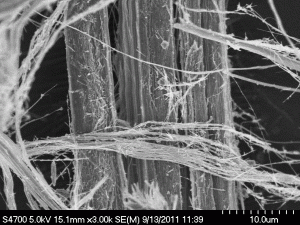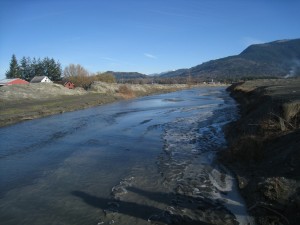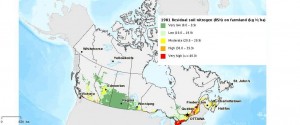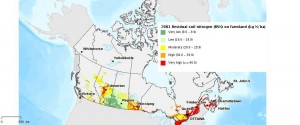Imagine finding out that your home was surrounded by a nano-sized toxicant. You couldn’t see it but it was in the air all around you, and you and your family were breathing it in with every breath. This is unfortunately a reality for people living in communities where Naturally Occurring Asbestos, or NOA, exists. NOA is asbestos that occurs in the soil or geology of a region – it wasn’t put there by human activities.
Asbestos refers to a group of fibrous minerals once considered miraculous due to their suitability for over 3000 industrial purposes, such as insulation and building materials. However, these miraculous minerals also pose a severe health hazard. Asbestos inhalation is linked to lung cancer and mesothelioma, a highly fatal cancer of the chest cavity.
Bundles of chrysotile asbestos, 5000X
Chrysotile, the most common form of asbestos, contains oxidizing metals, such as chromium, nickel, and iron, that are linked to the negative health effects of the fibers. There have been very few studies conducted on NOA chrysotile, and the health risks remain unclear. There is currently no consensus on how hazardous NOA is, or how it should be dealt with.
Asbestos becomes less toxic when the layer containing the oxidizing metals is leached from the surface. Weathering in the natural environment may alter the surface chemistry of asbestos fibers, making them less hazardous.
One of the communities struggling to deal with NOA is the Sumas Prairie in the Lower Fraser Valley. A landslide on Sumas mountain, WA, has been dumping asbestos rock into the Sumas river since the 1970’s. The asbestos material is carried down the river as sediment and deposited on the floodplain during flood events. When the sediment dries out, it can become airborne and pose an inhalation hazard to local residents.
The Sumas River with piles of asbestos laden sediment in front of the local homes.
For my Master’s research, I examined the surface chemistry of asbestos as it moved down the Sumas River, and before and after treatment with naturally occurring acids (oxalic, HCl, and carbonic), to determine if naturally occurring acids in soils and streams are removing the surface magnesium, and thus reducing the toxicity of the asbestos.
As the asbestos moves downstream, the surface chemistry of the asbestos fibers are altered, indicating that natural weathering is likely reducing the toxic effect of the fibers.
We may be able to speed up the rate the asbestos is detoxified by covering the asbestos contaminated floodplains with organic material. Organic material naturally forms organic acids, which over time will leach the heavy metals from the fibers. The organic matter layer will also cover the asbestos material preventing it from becoming airborne. If the fibers aren’t airborne, they won’t be inhaled by residents and thus, will not pose a health hazard.




